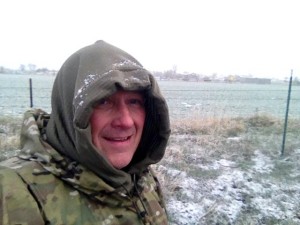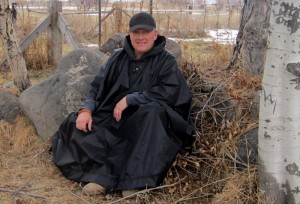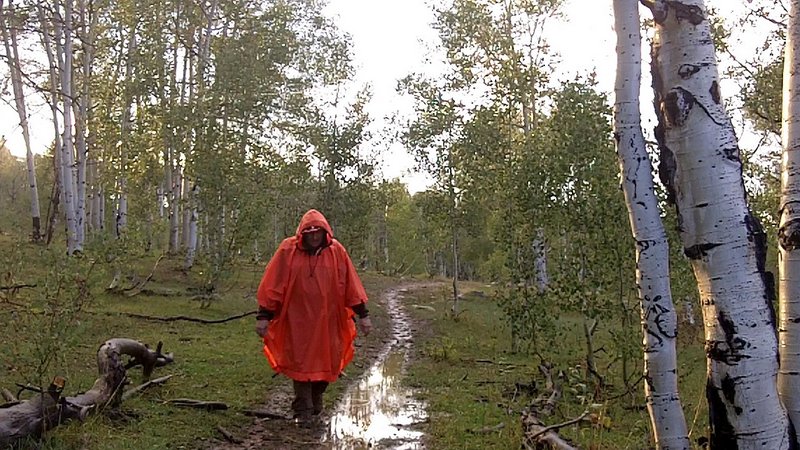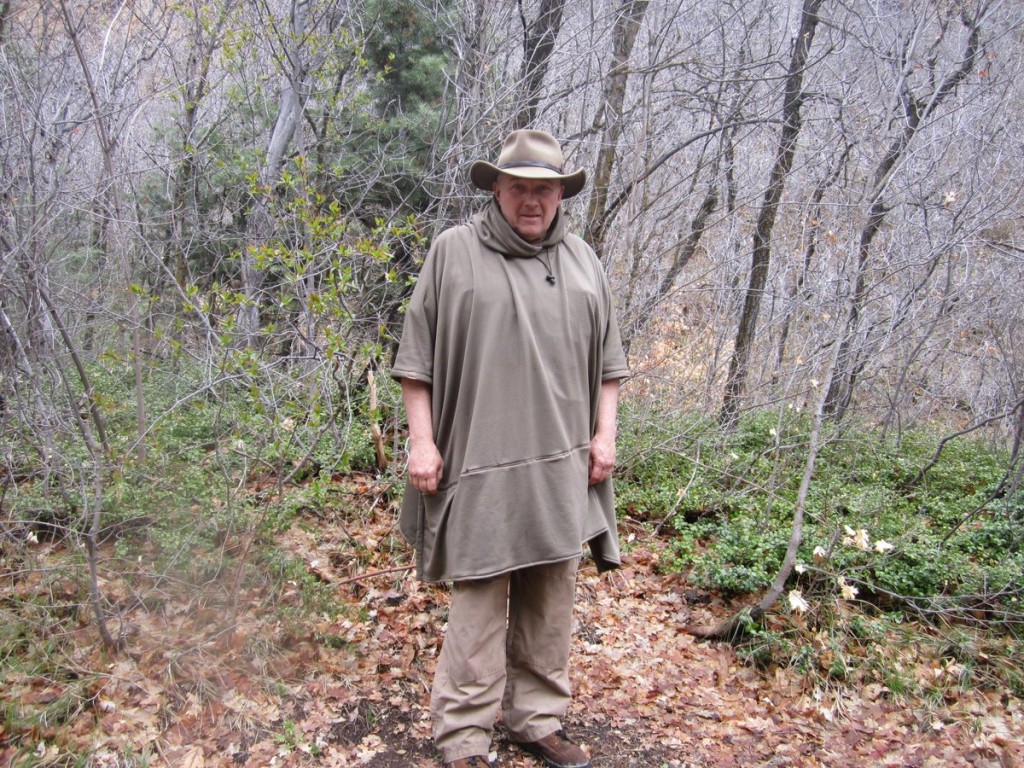In order to be properly prepared for cold/cool wet weather an outdoorsman should be able to live in it with no external assets. In other words ideally no need for fire to warm you or dry things, perhaps that’s a bit idealistic but a worthy goal that is somewhat attainable with simple gear like what we offer. Reputable survival instructors’ stress that the most important asset a person carries with them is the clothing they have. Certainly we can train to do without much of anything, reality though is very tough, unpredictable, and unforgiving. Not that the world itself is against man, nature just is, and man is not naturally equipped to survive in it, but man is a thinking reasoning being and very capable of adapting by ingenuity. The fault in depending on being able to make it in difficult circumstances without proper clothing is the unknown nature of situations, perhaps you may be injured, or there may be some with you unable to adapt and persevere. That being the case, if a person is at least minimally prepared with proper clothing and/or shelter, it will take much less effort to make up the difference it takes to get to the point of survivability.
As I have mentioned before, I have collected survival news stories and books for decades, it is sometimes astounding how easily people can die, even healthy folks. The temperature does not need to be freezing to be dangerous, in fact I contend that to the average person, 50° – 60° F, rainy and breezy are more likely to be more life threatening than cold and snow. Part of that reason is the perception that not much protective clothing is needed, and so they start out in a deficit in survivability score.
To me it is a thrill to get myself prepared in a way that rain, cold and wind are not factors to my comfort. From when I was a young man, I always wanted to be like the animals, able to be out in most any condition and be fine. To go about your camp in a most normal manner, all the while the rain is pouring down, the wind blowing, and perhaps some occasional snowflakes, is quite a good feeling to have. An example from a camp this spring, temperatures in the 30° F range and rain mixed with snow, no tent and no heating fire, windy at times.
Here is what I was wearing
- Poly cotton pants
- Long sleeved 100% poly T shirt
- Fingerless wool gloves
- Wool socks
- Water repellent boots
- Fleece Poncho Liner with hood, full length
- Poncho, full length (PSSL)
In that set up I was self-sustaining, I kept dry enough and warm enough that I was not cold while working about camp and while sitting in my camp chair relaxing.
There are three key factors to safely living in those conditions on a continual basis.
- Damp tolerable insulation
- Rain and moisture protection
- Wind protection
Our bodies can tolerate less than ten degrees differential internal temperature, before getting into fatally dangerous territory of heat or cold. We have to adapt ourselves to hot weather or cold wet weather by means mostly of clothing. I first started studying the subject of Hypothermia (cold body core temperature) in the mid 1980’s, starting with the book by Dr William Forgey Hypothermia: Death by Exposure. A great modern book that is very well detailed and easy to read is Cody Lundin’s “98.6 Degrees: The Art of Keeping Your Ass Alive” So deadly is the combination of cold, wet and windy, that a person can be dead in less than an hour in certain circumstances, far more deadly than most of the other things we worry about in the outdoors. Dressing improperly can kill you so fast it is stunning, a sudden rain and wind can catch an unprepared person so quickly they don’t even realize what is happening to them, till it’s too late.
So that’s enough bad news, I’m not usually one to harp on the “XX” will kill you line, but I needed to at least get it out there, if for no other reason than to emphasize the serious nature of this subject, it cannot be trifled with. The great news is that it doesn’t have to be that way, it is very possible to virtually eliminate the threat these conditions present. One of the books of real life experience I read early on was of Ernest Shackleton’s voyage of The Endurance, stranded near Antarctica in sea ice, the ship was crushed and the crew spent the next 18 months crossing the ice in bitter cold, rigging a boat to sail the icy seas, traversing a desolate mountain range. Remarkably not one of the crew perished.
Let me return to the list I posted above and detail it out for you, showing how you can easily prepare yourself against most of the hazards of cold, wet, windy conditions.
DAMP TOLERABLE INSULATION
Of all the insulations known to man probably one of the foremost is wool, it kept Shackleton’s crew alive, and also the crew of the Grafton who were marooned on Auckland Island located between New Zealand and Antarctica for nearly two years, as detailed in the book “Island of the Lost” For centuries woolen clothing was not only durable, but extremely protective of the people who wore it. Wool is unique in its ability to be warm even when wet.
One of the modern materials that is truly remarkable is Fleece. It is warm when damp, easy to dry, durable, compressible, soft and drapeable. There is wide variation in fleece quality, in our products we sell only authentic Polartec® is used. It is the highest quality product of its kind available anywhere in the world, and it is made in the U.S.A. It makes a nice blanket in both cool and warmer weather, we use it under our poncho as a liner, making essentially a long winter coat. I am constantly amazed at how well it works. I have stood in a light rain for hours without the poncho on, and have been amazed at how warm I stayed. Water does not like to stay in this fabric, but runs out the bottom.
Shirts and pants should be wool or poly, or poly cotton, the same goes for underclothing. Socks should be wool, or synthetic, never cotton in conditions like we are discussing. Wool or fleece gloves can help keep your hands warm, which is important in cool weather, as hands become clumsy when muscles become chilled.
I should point out one thing here, wool nor fleece nor any other fabric are as warm wet as they are dry, the cooling effect of water cannot be overcome by this clothing, if water can contact the skin, it will draw heat from the body. So while wool, fleece, poly and other fabrics can be good when damp or wet, it is still better to be dry.
RAIN AND MOISTURE PROTECTION
Since water can move heat thirty times faster than air, getting wet or having on wet clothing can be deadly, as body temperatures can quickly plunge to dangerous levels. Although most of us do not do blacksmithing, most of us have at least seen him work the red hot metal with hammers and other implements, then thrust it into a bucket of water, in seconds it is cool enough to hold in the hands. The effect of moisture or water on our skin or clothing cannot be understated. Even if our clothing is damp tolerable, there is still a penalty for wet clothing, in cool weather it is never as warm as dry clothing. If the clothing becomes saturated, water comes in contact with the skin and body heat quickly transfers to the cooler water, over time this can decrease the core temperature of the body, inviting Hypothermia. Some kind of rain gear is best in these conditions if you are out in it working, hiking or doing camp chores. If you can wait it out, a tarp or tent may keep you dry until conditions change, many people have tried to push on through it, and risked their lives. With a good poncho a person is able to safely continue on in most situations. As an example our poncho snaps up the sides providing some venting to help prevent excessive moisture build up from body function or condensation from temperature differential. The poncho fabric prevents rain from soaking clothing, additionally I often like to add the fleece liner even if I don’t need it for temperature as it adds a tremendous amount of comfort by helping to keep internal moisture away from the body.
Water resistant boots help keep moisture out of socks, especially when walking through puddles and streams. A hat with a brim all around is useful in times when you don’t have a poncho hood on.
WIND PROTECTION
If you have lived in areas where it gets hot and dry, you may have used an Evaporative Air Conditioner. These devices are very effective in dramatically cooling the air temperature. Combining moisture (water) in absorbent pads and air drawn through them, the resulting air blown out can be in the 45° F temperature range while it may be 100° F outside, quite a change! The same effect can happen to you with wet clothing and a blowing wind, it could be 60 F and you getting wet, then add a wind, the chilling action can take what would otherwise be a reasonably safe situation and turn it critical in not many minutes. Even if you get wet, if you can keep the wind off of you, it can add a huge margin of safety. Many years ago I worked in electronic security and we once did a project in a large food manufacturing facility. As food came out of cooking it went into racks and into a freezer where fans blew furiously, the effect quickly froze the food items for storage. The wind from the fans made a huge difference in how fast the food froze. This is why some wind protection can be invaluable, in fact lifesaving to us. Here again for me our poncho has worked miracles, it is long so it covers most of the body. I have probably used it as much for wind protection as rain.
A few years ago a friend and I were camping in the winter at over 9000 feet, as we hiked to our camp spot we encountered winds so strong they were difficult to stand up in. We put on our ponchos (PSSL) with the snap in fleece liners, the effect was amazing, although we could feel the strength of the wind, the cold was kept at bay and we were comfortable. Whether you are out in the winter or in other times of the year, having some protection from the wind can be a lifesaver. Remember that any temperature below the 70’s combined with wind and especially moisture can lead to hypothermia, it’s not just cold winters that are dangerous.
With a little bit of preparation, and a bit willingness to take along the things we know we should, we all can be considerably safer in the outdoors. I’m amazed by how many rescues are in the news, just for an overnight encounter, and the people go to the hospital being such tough shape, so “Be Prepared” and take some clothing or shelter items with you. In spite of this I know most people won’t, they only think of a quick hike and then back home, that’s what creates survival stories.
Until next time, this is Perry Peacock, “Simplifying Survival”





